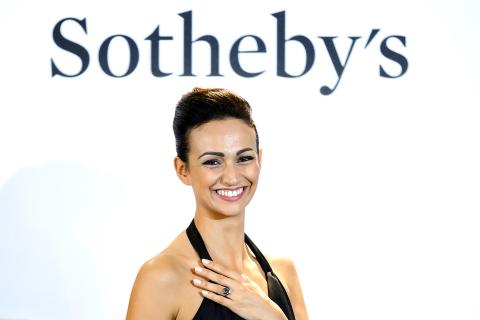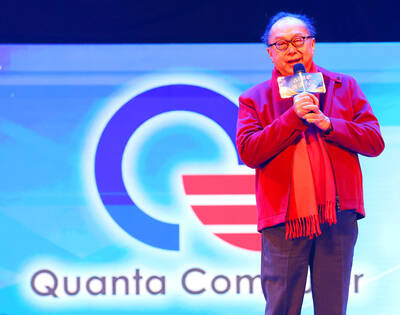They are not in the room rubbing shoulders with traditional wealthy buyers, instead choosing to remain in the shadows, making their multi-million US dollar bids by telephone.
Asian millionaires and billionaires last week discretely stole the show at a range of auctions, dishing out record sums for works of art and precious gemstones put on the block.
Auction houses Christie’s and Sotheby’s say the spectacular sales are part of a wider trend in which their business is increasingly turning toward Asia.

Photo: AFP
Christie’s Asia president Francois Curiel said that the auction house has quadrupled its Asia-based staff since 2010 to 220 to keep up with the demand.
“When I arrived in Hong Kong in 2010, our Asian clients represented 5 percent of our sales on a global scale. In 2014, they represented 31 percent,” he said.
The same is true of competing auction house Sotheby’s, where Asian clients today account for about one-third of global high-end jewelry sales, according to Sotheby’s Asia chairwoman Patti Wong (黃林詩).
“Asian participants make up a hugely important part of our global client base,” she said, adding that, over the past decade, Sotheby’s has “seen tremendous growth” from Asia.
Last week, Asian clients certainly took center stage.
The first spectacular hammer blow fell on Tuesday evening at a Christie’s art auction in New York, when former Chinese taxi driver turned billionaire financier Liu Yiqian (劉益謙) bought a famed Modigliani nude for more than US$170 million.
The 51-year-old tycoon, who made his fortune in real estate and finance in the 1990s, has made a string of purchases for his two museums in Shanghai.
The same day, Hong Kong property tycoon Joseph Lau (劉鑾雄) paid US$28.5 million for a huge 16.08-carat pink diamond at a Christie’s jewel auction in Geneva, Switzerland, and immediately renamed it “Sweet Josephine,” after his seven-year-old daughter. The auction house said it marked a world record for a pink diamond in the highest color category, “fancy vivid.”
Lau, 64, was not satisfied though.
On Wednesday, he struck again, snapping up a 12.03-carat blue diamond dubbed “Blue Moon” for a record US$48.4 million, this time at Sotheby’s in Geneva.
Sotheby’s international jewelry division chairman David Bennett said the “Blue Moon” sale broke several records, making the gemstone “the most expensive diamond, regardless of color, and the most expensive jewel ever sold at auction.”
The jewel, which is set in a ring, also fetched the highest-ever price per carat, with the buyer shelling out 4.02 million Swiss francs per carat, Bennett added.
The shimmering blue stone was also immediately renamed after Lau’s daughter, and is now called “The Blue Moon of Josephine.”
A Hong Kong-based spokeswoman for Lau confirmed the two diamond purchases.
This is not the first time Lau has bought rare jewels for his daughter. In 2009, he reportedly spent US$9.5 million on another blue diamond, which he renamed the “Star of Josephine.”
Josephine is his daughter with girlfriend and former aide Chan Hoi-wan (陳凱韻), according to local media. The 64-year-old also has two children with long-time partner Yvonne Lui (呂麗君).
Life is not all family bliss for Lau. In March last year, he was found guilty of bribing a former minister in the gambling enclave of Macau in an attempt to purchase a prime development site.
Lau, who was not in Macau for the sentencing, is unlikely to serve time, as the two semi-autonomous Chinese territories do not have an extradition agreement.

Intel Corp chief executive officer Lip-Bu Tan (陳立武) is expected to meet with Taiwanese suppliers next month in conjunction with the opening of the Computex Taipei trade show, supply chain sources said on Monday. The visit, the first for Tan to Taiwan since assuming his new post last month, would be aimed at enhancing Intel’s ties with suppliers in Taiwan as he attempts to help turn around the struggling US chipmaker, the sources said. Tan is to hold a banquet to celebrate Intel’s 40-year presence in Taiwan before Computex opens on May 20 and invite dozens of Taiwanese suppliers to exchange views

Application-specific integrated circuit designer Faraday Technology Corp (智原) yesterday said that although revenue this quarter would decline 30 percent from last quarter, it retained its full-year forecast of revenue growth of 100 percent. The company attributed the quarterly drop to a slowdown in customers’ production of chips using Faraday’s advanced packaging technology. The company is still confident about its revenue growth this year, given its strong “design-win” — or the projects it won to help customers design their chips, Faraday president Steve Wang (王國雍) told an online earnings conference. “The design-win this year is better than we expected. We believe we will win

Quanta Computer Inc (廣達) chairman Barry Lam (林百里) is expected to share his views about the artificial intelligence (AI) industry’s prospects during his speech at the company’s 37th anniversary ceremony, as AI servers have become a new growth engine for the equipment manufacturing service provider. Lam’s speech is much anticipated, as Quanta has risen as one of the world’s major AI server suppliers. The company reported a 30 percent year-on-year growth in consolidated revenue to NT$1.41 trillion (US$43.35 billion) last year, thanks to fast-growing demand for servers, especially those with AI capabilities. The company told investors in November last year that

Power supply and electronic components maker Delta Electronics Inc (台達電) yesterday said it plans to ship its new 1 megawatt charging systems for electric trucks and buses in the first half of next year at the earliest. The new charging piles, which deliver up to 1 megawatt of charging power, are designed for heavy-duty electric vehicles, and support a maximum current of 1,500 amperes and output of 1,250 volts, Delta said in a news release. “If everything goes smoothly, we could begin shipping those new charging systems as early as in the first half of next year,” a company official said. The new